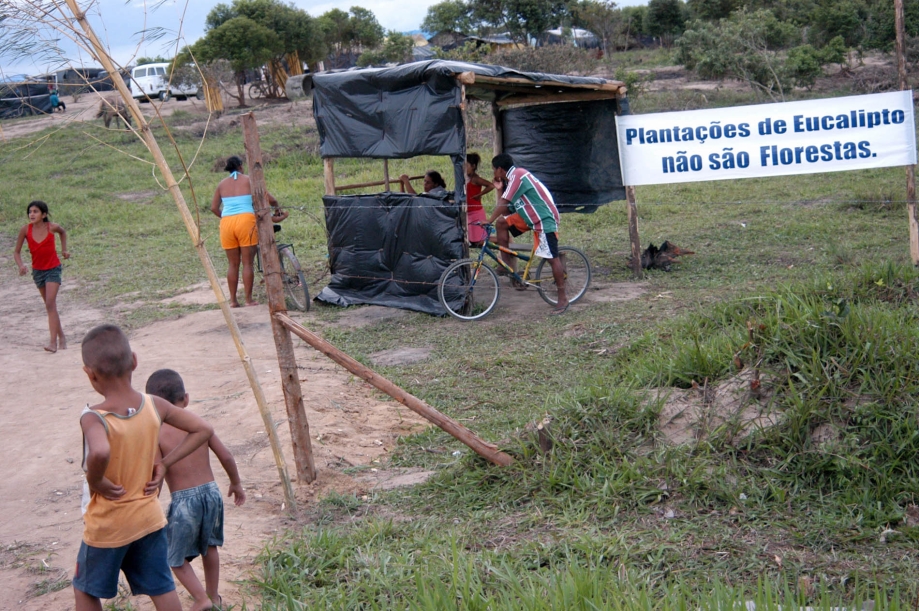

"Plantations of Eucalyptus are Not Forests"
For this camp, the MST took over portion of a eucalyptus plantation owned by timber company Aracruz Cellulose, removed the non-native trees and erected their tents, installed a well and built a community space using an elaborate system on non-hierarchical decision making. The camp was named Galdino dos Santos, for an indigenous chief who was murdered two years earlier in a racist attack.
MST Encampment: 25 Nov 2005
Orin Langelle | Espirito Santo, Brazil, Brazil
Organization: Langelle Photography
Photographer: Orin Langelle
Organization: Langelle Photography
Exhibit Title: MST Encampment: 25 Nov 2005
Location: Espirito Santo, Brazil, Brazil
This 2005 photo essay documents the Brazil’s Landless Worker’s Movement (Movimento dos Trabalhadores Rurais Sem Terra - MST) encampment named Galdino dos Santos in Espirito Santo, Brazil.
The essay is meant to explore the concept of who controls the land and what is used for? Who are the exploited and who are the exploiters?
The MST base their actions on Brazil’s Constitution, which states that land should fulfill a social function. The landless built the Galdino dos Santos’s encampment by taking the land from an industrial tree plantation timber company, Aracruz Cellulose.
This photo essay shows the people of the encampment in its early beginning.
The encampment was named for an indigenous leader, Galdino dos Santos, who was violently murdered in a racist attack in 1997.
Educator and theorist Paulo Freire’s last unfinished writing was about the murder of Galdino dos Santos. Freire said, “Disrespecting the weak, deceiving the unwary, offending life, exploiting others, discriminating against the Indian, the Black, the woman, will not be helping my children to be serious, just, and loving about life and others ...”
The following photos are from the Brazil Landless Worker’s Movement (Movimento dos Trabalhadores Rurais Sem Terra or MST) encampment named Galdino dos Santos, in Espirito Santo, Brazil.
The MST is a mass social movement, formed by rural workers and by those who want to fight for land reform and against injustice and social inequality in rural areas. The organization occupies unproductive land and develops it into encampments for landless people, with the aim to eventually transform the encampments into permanent settlements. The MST bases its actions on Brazil’s Constitution, which states that land should fulfill a social function. The MST has an estimated 1.5 million members across Brazil.
In 2005 I travelled with a group of with participants who were part of an international meeting in Vitoria, Brazil. The Vitoria meeting was organized to build support for local communities against large-scale tree plantations and genetically engineered (GE) trees. [1] The meeting was co-sponsored by World Rainforest Movement, FASE-ES and Global Justice Ecology Project – the same organizations are co-sponsoring a similar event in Vitoria this month.
Industrial tree plantations in Brazil have long been a target of the MST due to their many damaging impacts, including forced displacements, loss and contamination of water and soils, and massive deforestation.
The MST encampment we visited in 2005 had taken over portion of a plantation owned by timber company Aracruz Cellulose, removed the non-native trees and erected their camp. The encampment was young and they in were in the process of building a well and a community space, using an elaborate system on non-hierarchical decision making.The camp was named Galdino dos Santos, for an indigenous village leader who was murdered in a racist attack the day after Indigenous Peoples Day, 20 April 1997. Galdino dos Santos had participated in the Indigenous Peoples Day event, but afterward, when he fell asleep near his bus stop waiting to go back to his village, he was covered with alcohol and set on fire.
Paulo Freire’s Meeting with the MST [AP1] [2] and Freire’s last unfinished writing was on the murder of Galdino dos Santos:
Our memory of Paulo Freire tells us that he lived simply, always off to the side, never distancing himself from his people. A man who studied and wrote until the end of his life, capable of being angry at the injustice committed anywhere in the world. Let us remember his last, unfinished writing, left on the table, in the form of a Pedagogical Letter, which deals with the murder of Galdino Jesus dos Santos – a Pataxó Indian, in Brasília. So he said goodbye to us: [AP2][MOU3]“Disrespecting the weak, deceiving the unwary, offending life, exploiting others, discriminating against the Indian, the Black, the woman, will not be helping my children to be serious, just, and loving about life and others ... (Freire, 2000a, p. 67).
The MST … through a process of occupying latifundios (large landed estates) … became a national movement in 1984. Over more than two decades, the movement has led more than 2,500 land occupations, with about 370,000 families - families that today settled on 7.5 million hectares of land that they won as a result of the occupations. Through their organizing, these families continue to push for schools, access to health care, credit for agricultural production and cooperatives. [3]
NOTES:
[1] Vitoria Statement at an international meeting on building support for local communities against large-scale tree plantations and GMO trees
https://www.wrm.org.uy/other-information/the-vitoria-statement-in-support-of-the-struggles-of-local-peoples-against-large-scale-tree-plantations
[2] Paulo Freire’s Meeting with the MST https://mstbrazil.org/content/paulo-freire%E2%80%99s-meeting-mst
[3] What is the MST https://www.mstbrazil.org/content/what-mst
World Rainforest Movement
FASE-ES
Global Justice Ecology Project
Orin Langelle
POB 124
Randolph, NY 14772 US
+1.716.536.5669
Make Comment/View Comments